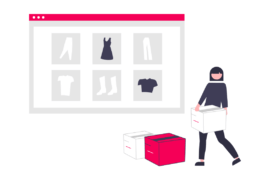Two common approaches to ad serving are Header bidding and Waterfall. In this blog post, we have explained header bidding vs waterfall and provided recommendations on which one may be most appropriate for various scenarios.
Ad serving is a crucial aspect of digital advertising. It allows advertisers and publishers to serve targeted ads to specific audiences. However, choosing the right ad-serving approach can be daunting, especially with the numerous available options.
Header bidding is a recent ad-serving approach that is gaining rapid momentum among publishers. It lets publishers offer their ad inventory to multiple ad networks simultaneously, fostering real-time bidding and competition for ad impressions. This approach produces higher CPMs and fills rates than traditional waterfall ad serving.
Recently, a new optimized version of header bidding, named hybrid header bidding born out of necessity, that offers a flexible, efficient and, most importantly, transparent alternative to waterfall bidding.
Hybrid header bidding supports both client-side and S2S to optimize the bidding process for publishers. (Source: Europeanbusinessreview)
In contrast, waterfall ad serving offers ad inventory to one ad network at a time based on a predetermined priority order. While waterfall ad serving is easier to manage than header bidding, it may not generate the same revenue or provide the same level of transparency.
In the remainder of this blog post, we will explore the advantages and disadvantages of each approach, as well as their specific use cases.
By the end of this post, you will better understand the differences between header bidding and waterfall ad serving and which approach may be best suited for your particular needs.
Also Check: A Comprehensive Guide to Header Bidding
Header Bidding vs. Waterfall
To help you decide which approach to use for your advertising campaigns, let’s compare header bidding and waterfall ad serving side-by-side:
1. CPMs
Header bidding typically generates higher CPMs than waterfall ad serving due to increased competition for ad inventory.
2. Fill Rates
Header bidding also tends to result in higher fill rates than waterfall ad serving, as multiple demand sources are bidding on ad inventory simultaneously.
3. Revenue
Overall, header bidding can generate a higher revenue than waterfall ad serving due to its ability to generate higher CPMs and fill rates.
4. Technical Complexity
Header bidding is more technically complex than waterfall ad serving, requiring advanced JavaScript and web development knowledge.
5. Ease of Use
Waterfall ad serving is more straightforward and accessible than header bidding, as ad inventory is offered to ad networks in a predetermined order.
6. Transparency
Header bidding provides greater transparency into the bidding process compared to waterfall ad serving, enabling publishers to understand the actual value of their ad inventory.
Comparison Table
| Header Bidding | Waterfall Ad Serving | |
CPMs | Typically higher due to competition | Typically lower due to lack of competition |
| Fill Rates | Higher due to multiple demand sources bidding simultaneously | Lower due to ad networks being offered inventory in a pre-determined order |
| Technical Complexity | More technically complex, requiring advanced knowledge of JavaScript and web development | Simpler and easier to use |
| Transparency | Provides greater transparency into the bidding process, enabling publishers to understand the true value of their ad inventory | Provides less transparency into the bidding process, making it difficult for publishers to understand the true value of their ad inventory |
| Control | Provides more control over ad inventory and enables publishers to optimize their ad revenue | Provides limited control over ad inventory |
| User Experience | Can result in slower page load times, potentially impacting user experience | Generally faster page load times |
What Exactly is Header Bidding?
As mentioned earlier in the blog, header bidding is an innovative technique used in programmatic advertising. It enables publishers to simultaneously offer their ad inventory to numerous demand sources, including ad networks, ad exchanges, and demand-side platforms (DSPs).
This method has gained popularity due to its potential to give publishers greater control over their inventory and potentially higher CPMs and fill rates than the conventional waterfall ad-serving approach.
How Header Bidding Works?
One approach to ad serving involves inserting a JavaScript code into the header of a website, allowing demand sources to compete for ad inventory in real time.
This process involves a user visiting the website, with the header bidding code sending requests to multiple demand sources simultaneously. Each source can bid on the available ad inventory, with the highest bidder selected to serve the ad to the user in real time.
Why Header Bidding is Becoming Popular?
Header bidding has become more prevalent in recent years for several reasons:
- Higher CPMs: By allowing multiple demand sources to bid on ad inventory simultaneously, header bidding can result in higher CPMs than traditional waterfall ad serving.
- Increased Competition: Header bidding increases ad inventory competition, leading to higher fill rates and revenue for publishers.
- More Control: Header bidding gives publishers more control over their inventory and enables them to optimize their ad revenue.
- Improved Transparency: Header bidding provides greater transparency into the bidding process and helps publishers understand the actual value of their ad inventory.
Client-Side vs. Server-Side Header Bidding
Client-side and server-side header bidding are both methods for publishers to increase their ad revenue by creating a real-time auction for ad space on their website. They differ in where the auction takes place:
Client-side header bidding: The auction happens within the user’s web browser. The publisher’s website sends out multiple requests to various ad exchanges and Supply-Side Platforms (SSPs) simultaneously. These exchanges then bid on the ad space, and the highest bidder wins.
Server-side header bidding: The auction occurs on a server managed by a third-party vendor. The publisher’s website sends a single request to this server, which then sends out requests to ad exchanges and SSPs. The bids are collected and returned to the publisher’s server, which determines the winner and sends the ad code back to the user’s browser.
Here’s a breakdown of some key differences:
- Speed: Since client-side auctions happen in the user’s browser, they can slow down page load times, especially if there are many bidders. Server-side auctions are faster because the browser only needs to make one request.
- Scalability: Client-side bidding is limited by the number of connections a browser can handle. Server-side bidding can connect to many more bidders.
- Transparency: With client-side bidding, publishers have more control and visibility into the bidding process. Server-side bidding can be like a “black box” where the publisher has less control.
- Setup: Client-side bidding is generally easier to set up, but requires more ongoing maintenance. Server-side bidding often requires working with a third-party vendor and can be more complex to implement.
| Feature | Client-Side Header Bidding | Server-Side Header Bidding |
| Location of Auction | User’s Browser | Third-Party Vendor Server |
| Speed | Slower | Faster |
| Scalability | Limited | More Scalable |
| Transparency | More Control | Less Control (Black Box) |
| Setup | Easier to Set Up | More Complex |
Choosing between client-side and server-side depends on your priorities:
If maximizing revenue is your top concern and you have a fast website, client-side bidding might be a good option. If user experience and fast page loads are most important, server-side bidding is a better choice.
Pros and Cons of Header Bidding
Header bidding has several advantages and disadvantages compared to traditional waterfall ad serving. Here are some of the key pros and cons to consider:
Pros of Header Bidding
- Higher Revenue Potential: Header bidding enables publishers to offer ad inventory to multiple demand sources simultaneously, which can lead to increased competition and higher revenue potential compared to traditional waterfall ad serving.
- Increased likelihood of Ad Inventory being Filled: Header bidding can increase the likelihood of ad inventory being filled by multiple demand sources, which can result in higher fill rates and revenue for publishers.
- Greater Flexibility and Customization: Header bidding gives publishers more flexibility and customization options for their ad inventory, which can lead to greater control over ad revenue and user experience.
- Enhanced Understanding of the Bidding Process: Header bidding provides more transparency into the bidding process and can help publishers better understand the actual value of their ad inventory.
Cons of Header Bidding
- Advanced Technical Expertise Required: The header bidding implementation demands high technical knowledge, such as proficiency in JavaScript and web development.
- Potential for Slower Website Performance: The use of header bidding may cause slower page load times, potentially leading to a poor user experience and adverse effects on SEO.
- Possible Delays: Header bidding has the potential to introduce latency into the bidding process, which can result in longer load times and a less seamless user experience for website visitors.
While header bidding has several advantages compared to traditional waterfall ad serving, it has some potential downsides. Publishers should carefully weigh the pros and cons when deciding which approach to use for their advertising campaigns.
That said, let’s now talk about waterwall ad serving.
What is Waterfall Ad Serving?
Waterfall ad serving is a classic technique prevalent over the years. Ad inventory is sequentially offered to a single ad network using this method, based on a previously set priority order. Waterfall ad-serving was widely adopted as the primary ad-serving approach before header bidding.
Why Waterfall Ad Serving Was Traditionally Popular?
Waterfall ad serving was traditionally famous for several reasons:
- Simplicity: Waterfall ad serving is a simple and easy-to-use approach to ad serving that doesn’t require advanced technical expertise.
- Ease of Management: With waterfall ad serving, ad inventory is offered to ad networks in a predetermined order, making it easy to manage and optimize ad revenue.
- Prioritization: Waterfall ad serving enables publishers to prioritize specific ad networks over others based on factors such as fill rate and revenue.
How Waterfall Ad Serving Works?
One approach to ad serving involves offering ad inventory to ad networks in a predetermined order. If the first ad network cannot fill the inventory, the request moves to the following ad network until the inventory is filled or all networks have been tried. This approach is commonly referred to as “waterfall ad serving.”
Also Read: 10 Best Ad Servers for Publishers [in 2023]
Pros and Cons of Waterfall Ad Serving
Waterfall ad serving and header bidding are two distinct approaches to ad serving, each with advantages and disadvantages. To make an informed decision about which approach to use for your advertising campaigns, it’s essential to carefully consider the specific needs and goals of your website or business.
Let’s briefly explore some key pros and cons of waterfall ad serving compared to header bidding.
Pros of Waterfall Ad Serving
- Simplicity: Waterfall ad serving is a straightforward and user-friendly approach to ad serving that doesn’t require advanced technical knowledge.
- Ease of Management: Waterfall ad serving offers ad inventory to ad networks in a predetermined order, simplifying managing and optimizing ad revenue.
- Prioritization: Publishers using waterfall ad serving can prioritize specific ad networks over others based on factors like fill rate and revenue.
Cons of Waterfall Ad Serving
- Lower Revenue Potential: Some ad experts suggest that waterfall ad serving may offer less revenue than header bidding, as it provides a different level of real-time competition for ad impressions.
- Limited Insight into the Bidding Process: It’s worth noting that waterfall ad serving can provide less insight into the bidding process, potentially making it harder for publishers to understand the value of their ad inventory fully.
- Control Limitations: Publishers using waterfall ad serving may face some limitations regarding inventory control, potentially impacting their ability to optimize ad revenue in the same way that header bidding might allow.
Although waterfall ad serving has particular benefits compared to header bidding, some factors must be considered. Publishers should thoroughly assess the advantages and disadvantages before selecting an ad-serving approach for their advertising campaigns.
There’s more to waterfall method, and next in the list is programmatic waterfall, which you may have heard if you have been keeping a close eye on ad tech sector. Let’s understand what is really is.
Programmatic Waterfall Explained
A programmatic waterfall, also known as daisy chaining, is a technique used by publishers to sell unsold ad inventory through programmatic advertising.
Here’s how it works:
- Premium vs. Remnant Inventory: Publishers typically sell their most desirable ad space through direct deals with advertisers, which guarantees a higher price. However, some ad space might not be attractive enough for direct deals and goes unsold – this is called remnant inventory.
- Waterfall Steps: The publisher sets up a list of ad networks or Sell-Side Platforms (SSPs) in a specific order, prioritizing those with a history of good performance (eCPM, fill rate, etc.).
When there’s an ad request for remnant space, the publisher’s ad server sends it to the first SSP on the list.
- Bidding and Filling: The SSP tries to sell the ad impression to advertisers in its network through a real-time auction.
If the SSP finds a buyer that meets the publisher’s minimum price floor, the ad is filled, and the process ends.
- Down the Waterfall: If the first SSP can’t sell the ad impression, the request goes to the next SSP on the list. This process continues down the waterfall until an SSP finds a buyer or the list is exhausted.
- Unsold Inventory: If none of the SSPs can sell the ad impression, the publisher might choose to display a house ad (their own promotion) or leave the space blank.
Pros of Programmatic Waterfall:
- Simple and Easy to Implement: Easy to set up and understand, making it accessible for publishers with less experience in programmatic advertising.
- Control over Order: Publishers have control over the order in which SSPs are contacted, allowing them to prioritize those with a good track record.
Cons of Programmatic Waterfall:
- Limited Revenue Potential: Since SSPs are contacted sequentially, the highest bidder might be missed if they are lower down on the list. This can lead to lower overall revenue compared to other methods like header bidding.
- Potential for Latency: The sequential nature can cause delays as the ad request moves through each SSP, impacting user experience with slower page loads.
Overall, programmatic waterfalls are a good option for beginners in programmatic advertising, but for maximizing revenue and user experience, publishers often look to more advanced techniques like header bidding.
How Does Programmatic Waterfall Work?
Programmatic waterfalls offer a way for publishers to fill unsold ad space on their websites. When ad space remains after direct deals with advertisers, a programmatic waterfall kicks in. The publisher creates a list of ad networks or platforms (SSPs) ranked by past performance. The ad server then sends requests down this list, one by one. Each SSP auctions the ad space to its network of advertisers in real-time. If a bidder meets the publisher’s minimum price, the ad is sold and the process ends.
However, if none of the SSPs find a buyer, the publisher might end up displaying their own ad or leaving the space blank. While programmatic waterfalls are simple to implement, they can be inefficient. Higher-paying bids might be missed if placed lower on the list. This is a limitation that more advanced techniques like header bidding aim to overcome.
When to Use Header Bidding or Waterfall Ad Serving?
Choosing between header bidding and waterfall ad serving can depend on various factors, including website traffic, audience demographics, and ad inventory. Here are some use cases to consider:
When to Use Header Bidding?
- High-Traffic Websites: Header bidding is often most effective for high-traffic websites, enabling real-time bidding and competition for ad impressions.
- Diverse Audience Demographics: If a website’s demographics are diverse, header bidding can ensure that ads are targeted to the most relevant users.
- Premium Ad Inventory: If a website has premium ad inventory, such as video or high-impact display ads, header bidding can help ensure the inventory is sold at the highest possible price.
When to Use Waterfall Ad Serving?
- Lower-Traffic Websites: Waterfall ad serving can be adequate for lower-traffic websites that may have less demand for their ad inventory.
- Simple Ad Inventory: If a website has a relatively simple ad inventory, such as standard display ads, waterfall ad serving can be effective and easy to manage.
- Limited Technical Resources: If a website has limited technical resources, waterfall ad serving may be a more straightforward and more manageable approach to ad serving.
Conclusion
Choosing the best ad-serving approach is essential for publishers and advertisers, as it can significantly impact revenue and user experience.
Header bidding and waterfall ad serving are two common approaches with unique advantages and disadvantages.
Header bidding typically generates higher revenue and offers more control and transparency but may require more technical expertise and can result in slower page load times. Waterfall ad serving is simpler and easier to use but may result in lower revenue and less control and transparency.
The two decisions will depend on website traffic, audience demographics, and ad inventory. High-traffic websites with premium ad inventory may benefit most from header bidding, while lower-traffic websites may find waterfall ad serving more appropriate.
By carefully weighing the pros and cons and considering specific use cases, publishers can choose an approach that best suits their needs and maximize revenue and user experience.
FAQ: Header Bidding vs Waterfall
Header bidding tends to generate a higher revenue than waterfall ad serving due to its ability to generate higher CPMs and fill rates.
Header bidding is generally more technically complex than waterfall ad serving, requiring advanced JavaScript and web development knowledge.
Header bidding generally provides more control and transparency compared to waterfall ad serving, enabling publishers to optimize their ad revenue and understand the actual value of their ad inventory.
Header bidding is often most effective for high-traffic websites, enabling real-time bidding and competition for ad impressions.
Waterfall ad serving can be adequate for lower-traffic websites that may have less demand for their ad inventory.
Factors such as website traffic, audience demographics, ad inventory, and technical resources should be considered when deciding between header bidding and waterfall ad serving.





![28 Best Supply Side Platforms (SSP) for Publishers in 2024 [The Complete List] Supply Side Platforms](https://www.adpushup.com/blog/wp-content/uploads/2022/05/undraw_chore_list_re_2lq8-270x180.png)

